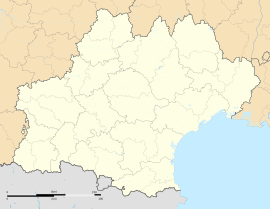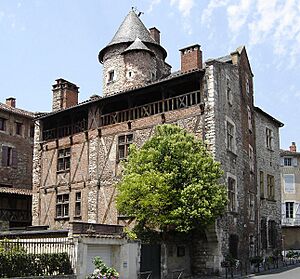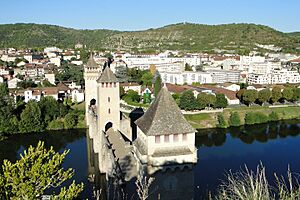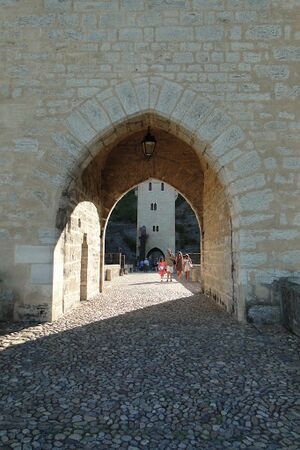Cahors facts for kids
Quick facts for kids
Cahors
Caors (Occitan)
|
|||
|---|---|---|---|
|
Prefecture and commune
|
|||

|
|||
|
|||
| Country | France | ||
| Region | Occitanie | ||
| Department | Lot | ||
| Arrondissement | Cahors | ||
| Canton | Cahors-1, 2 and 3 | ||
| Intercommunality | CA Grand Cahors | ||
| Area
1
|
64.72 km2 (24.99 sq mi) | ||
| Population
(2022)
|
19,902 | ||
| • Density | 307.509/km2 (796.45/sq mi) | ||
| Time zone | UTC+01:00 (CET) | ||
| • Summer (DST) | UTC+02:00 (CEST) | ||
| INSEE/Postal code |
46042 /46000
|
||
| 1 French Land Register data, which excludes lakes, ponds, glaciers > 1 km2 (0.386 sq mi or 247 acres) and river estuaries. | |||
Cahors is a historic city in the western part of Southern France. It is the main city and capital of the Lot department. Cahors is home to about 20,000 people.
The city is built in a bend of the Lot River. It is surrounded by steep, rocky hills. Cahors has many old buildings from Roman times and the Middle Ages. These include the Saint-Étienne cathedral, old Roman walls, and the famous Valentré bridge. This bridge is so important that it is a World Heritage Site recognized by UNESCO.
Cahors is also known for its special wine and delicious food. Local treats include truffles and foie gras. The city is recognized as a "French Town of Art and History." Its economy mainly relies on services, making it the business center of the Lot department.
Contents
History of Cahors
Cahors has a long and interesting history. It started in Celtic times. The original name was Divona, or Divona Cadurcorum. Divona was a special fountain, now called "la fontaine des Chartreux." The Cadurci people, a Celtic tribe, worshipped this fountain.
The Cadurci were one of the last Celtic tribes to fight against the Roman invasion around 50 BC. The name Cahors comes from Cadurcorum. After the Romans took over, Cahors quickly became a large Roman city. You can still see parts of its Roman buildings today.
The city's economy became less strong after the Middle Ages. Its university closed in the 1700s. Today, Cahors is a popular place for tourists. People visit to see its medieval area and the Valentré bridge, which was built in the 1300s. Cahors is also the home of the Diocese of Cahors, which is a church district.
In the Middle Ages, some people from Cahors were known as "Cahorsins." They were Christians who charged interest on loans. At that time, the church believed that charging interest on money was wrong. Because of this, Cahors was sometimes linked to this idea of wrongdoing.
Pope John XXII was born in Cahors in 1244. He became Pope from 1316 to 1334.
Cahors has also been part of the famous Tour de France bicycle race. It was the starting point for a stage in 2007. In 2022, it was the finish line for stage 19 of the race.
Geography of Cahors
The town of Cahors is about 115 kilometers (71 miles) north of Toulouse. It is located on the RN20 / A20 road, which connects it to Paris and Orléans. The city's elevation above sea level ranges from 105 meters (344 feet) to 332 meters (1,089 feet). The total area of the town is about 64.72 square kilometers (25 square miles).
Population of Cahors
Cahors has a population of around 20,000 people. The number of people living in Cahors has stayed quite steady over the past few decades. For example, in 1968, there were about 19,128 residents, and by 2017, the population was around 19,878.
Main Places to See
- The Valentré Bridge is the most famous symbol of Cahors. Its construction started in 1308 and finished in 1378. There's a famous legend about the bridge and the devil. When the bridge was fixed in 1879, the architect Paul Gout added a small sculpture of the devil on top of one of the towers.
- Cathédrale Saint-Étienne is a very important national monument.
- Saint-Barthélémy Church was built in the 14th century.
- Maison Henri IV or Hôtel de Roaldès is a beautiful house from the 15th century.
- The Daurade quarter has several old houses, including Maison Hérétié (14th–16th centuries), Maison Dolive (17th century), and Maison du Bourreau (13th century).
- The Arc de Diane is what remains of ancient Roman baths.
- The Roman Amphitheatre is another ancient Roman site. You can see parts of its stone walls in the first level of the underground car park at Place Gambetta. These remains were opened to the public in 2009.
Cahors Wine
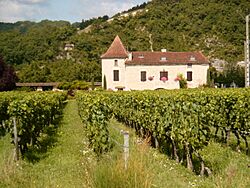
The area around Cahors is famous for making wine. It mostly produces strong red wines that are rich in flavor. To be called a Cahors wine, it must be made from at least 70% Malbec grapes. Up to 30% of the wine can also come from Merlot or Tannat grape varieties.
Culture and Events
The Cahors Blues Festival is a popular music event that happens every year in July. It has been taking place since 1982.
Education in Cahors
Cahors once had its own university, the University of Cahors. It was founded in 1331 by Pope John XXII. The university had different colleges and taught subjects like theology, law, medicine, and arts. In 1751, the University of Cahors joined with the University of Toulouse.
Notable People from Cahors

Many interesting people have come from Cahors or have strong connections to the city:
- Pope John XXII (1244 – 1334) was born in Cahors and became Pope.
- Clément Marot (1496–1544) was a famous poet during the Renaissance period.
- Léon Gambetta (1838-1882) was an important lawyer and politician. He helped declare the French Third Republic in 1870.
- Marcel Marceau (1923–2007) was a world-famous actor and mime artist. He passed away in a rest home in Cahors.
- Fabien Galthié (born 1969) is a well-known rugby union player. He is now the head coach of the French national rugby team.
Climate
| Climate data for Cahors (Le Montat) (1991–2020 normals, extremes 1986–present) | |||||||||||||
|---|---|---|---|---|---|---|---|---|---|---|---|---|---|
| Month | Jan | Feb | Mar | Apr | May | Jun | Jul | Aug | Sep | Oct | Nov | Dec | Year |
| Record high °C (°F) | 19.6 (67.3) |
25.9 (78.6) |
26.4 (79.5) |
31.0 (87.8) |
34.5 (94.1) |
40.2 (104.4) |
40.0 (104.0) |
43.3 (109.9) |
35.7 (96.3) |
34.6 (94.3) |
23.8 (74.8) |
18.3 (64.9) |
43.3 (109.9) |
| Mean daily maximum °C (°F) | 9.1 (48.4) |
10.9 (51.6) |
15.1 (59.2) |
18.2 (64.8) |
22.0 (71.6) |
25.9 (78.6) |
28.7 (83.7) |
28.7 (83.7) |
24.4 (75.9) |
19.3 (66.7) |
12.9 (55.2) |
9.6 (49.3) |
18.7 (65.7) |
| Daily mean °C (°F) | 5.4 (41.7) |
6.2 (43.2) |
9.6 (49.3) |
12.3 (54.1) |
15.8 (60.4) |
19.5 (67.1) |
21.8 (71.2) |
21.8 (71.2) |
17.9 (64.2) |
14.1 (57.4) |
8.8 (47.8) |
6.0 (42.8) |
13.3 (55.9) |
| Mean daily minimum °C (°F) | 1.7 (35.1) |
1.5 (34.7) |
4.2 (39.6) |
6.5 (43.7) |
9.6 (49.3) |
13.1 (55.6) |
15.0 (59.0) |
14.9 (58.8) |
11.5 (52.7) |
9.0 (48.2) |
4.8 (40.6) |
2.3 (36.1) |
7.8 (46.0) |
| Record low °C (°F) | −20.0 (−4.0) |
−12.5 (9.5) |
−11.6 (11.1) |
−3.2 (26.2) |
0.4 (32.7) |
4.0 (39.2) |
7.2 (45.0) |
5.1 (41.2) |
2.0 (35.6) |
−5.8 (21.6) |
−8.7 (16.3) |
−11.4 (11.5) |
−20.0 (−4.0) |
| Average precipitation mm (inches) | 76.9 (3.03) |
60.2 (2.37) |
60.5 (2.38) |
73.4 (2.89) |
80.4 (3.17) |
78.1 (3.07) |
49.6 (1.95) |
60.9 (2.40) |
69.1 (2.72) |
65.1 (2.56) |
73.5 (2.89) |
76.9 (3.03) |
824.6 (32.46) |
| Average precipitation days (≥ 1.0 mm) | 11.8 | 10.0 | 10.2 | 10.4 | 10.1 | 8.0 | 6.6 | 7.2 | 8.0 | 9.1 | 10.9 | 11.7 | 114.1 |
| Mean monthly sunshine hours | 84.1 | 128.2 | 168.8 | 193.3 | 220.7 | 250.6 | 272.0 | 253.0 | 221.0 | 152.8 | 103.0 | 94.3 | 2,141.9 |
| Source: Meteociel | |||||||||||||
See also
 In Spanish: Cahors para niños
In Spanish: Cahors para niños





